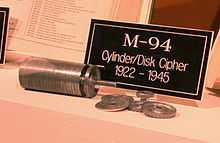M-94
- M-94 can also refer to a state trunkline in the U.S. state of Michigan. For the highway see, M-94 (Michigan highway)

The M-94 was a piece of cryptographic equipment used by the United States army, consisting of several lettered discs arranged as a cylinder. The idea for the device was conceived by Colonel Parker Hitt and then developed by Major Joseph Mauborgne in 1917. Officially adopted in 1922, it remained in use until 1945, replaced by more complex and secure electromechanical rotor machines, particularly the M-209. The M-94 was also employed by the US Navy under the name CSP 488.
The device consisted of 25 aluminium discs attached to a four-and-a-half inch long rod, each disc containing the 26 letters of the Roman alphabet in scrambled order around its circumference (with the exception of the 17th disc, which began with the letters "ARMY OF THE US"). Each wheel had a different arrangement of the alphabet, and was stamped with an identifying number and letter; wheels were identified according to the letter following "A" on that wheel, from "B 1" to "Z 25". The wheels could be assembled on the rod in any order; the ordering used during encoding comprised the key. There were 25! (25 factorial) = 15,511,210,043,330,985,984,000,000 (more than 15 septillion) possible keys, which can be expressed as about an 84-bit key size.
Messages were encrypted 25 letters at a time. Turning the discs individually, the operator aligned the letters in the message horizontally. Then, any one of the remaining lines around the circumference of the cylinder was sent as the ciphertext. To decrypt, the wheels were turned until one line matched a 25 letter block of ciphertext. The plaintext would then appear on one of the other lines, which could be visually located easily, as it would be the only one likely to "read."
A variant, called a strip cipher, had each scrambled alphabet, repeated twice, printed on a metal strip that could be slid back and forth in a frame (see photo).

The principle upon which the M-94/CSP-488 is based is at least as old as the 15th century, when the revolving wheel cryptograph was envisioned by Leone Battista Alberti. Thomas Jefferson independently invented a similar device in 1790, which had 36 disks.
Wheel ciphers could be broken, even in World War II, if enough ciphertext was intercepted. However, this took time and specialized skills, so the M-94 was still good enough for tactical communications. The DRYAD cipher currently in use by the U.S. military is not much more sophisticated.
See also
External links
- DESCRIPTION OF CSP-488 a.k.a. M-94
- Jerry Proc's page on the M-94
- Pictures of the M-94
- Instructions for the Cylindrical Cipher Device, U.S. Navy, 1926
| ||||||||||||||||||||||||||||||||